How to Choose the Manufacturing Materials of Machine Parts?

The manufacturing materials of machine parts are diverse, and the manufacturing materials determine their characteristics and applicable scenarios. We need to consider the following factors when choosing the manufacturing materials of machine parts.
The size and nature of the load
This factor is mainly considered from the point of view of the strength of the part, and the selection should be made on the premise of fully understanding the machine properties of the material.
In principle, brittle materials are only suitable for manufacturing parts that work under static loads. In the case of impact, plastic materials should be selected.
The performance of metal materials can generally be improved and improved by heat treatment. Therefore, it is necessary to make full use of heat treatment methods to realize the potential of the material. For commonly used quenched and tempered steel, due to its different tempering temperatures, blanks with different mechanical properties can be obtained.
Working condition of parts
The working condition of the part refers to the environmental characteristics, working temperature, friction, and wear degree of the part.
For parts that work in hot and humid environments, the materials should have good rust and corrosion resistance, such as stainless steel and copper alloys.
For the working temperature of machine parts, on the one hand, it is necessary to consider that the linear expansion coefficients of the materials of the two parts that cooperate with each other should not be too different, so as to avoid excessive thermal stress when the temperature changes. On the other hand, consider the fact that the machine properties of the material will change with temperature.
Parts may be worn during work, so the surface hardness should be increased to increase wear resistance. Therefore, quenched steel, carburized steel, nitrided steel, and other varieties suitable for surface treatment should be selected.
Size and quality of machine parts
The size and quality of the parts are related to the type of material and the method of preparing the blank. When casting materials are used to make blanks, they are generally not limited by size and quality.
When using forging materials to manufacture blanks, attention must be paid to the production capacity of forging machinery and equipment. In addition, the size and quality of the parts are also related to the strength-to-weight ratio of the material. Materials with a large strength-to-weight ratio should be used as much as possible to reduce the size and quality of the parts.
The complexity of the part structure and the processing possibility of the material
The parts with complex structures should be formed by casting blanks, or stamping out the components from plates and then welding them. Parts with a simple structure can be used for forging to obtain blanks.
The understanding of material manufacturability plays an important role in judging the possibility of processing. The manufacturability of the casting material refers to the liquid fluidity, shrinkage rate, degree of segregation, and tendency of shrinkage cavity of the material. The manufacturability of forging materials refers to the ductility, hot brittleness, and plastic deformation ability of the material in cold and hot states.
The manufacturability of welding materials refers to the weldability of materials and the tendency of welds to crack. The heat treatment processability of the material refers to the material's hardenability, the tendency of quenching deformation, and the permeability of the heat treatment medium to it. Cold working processability refers to the hardness of the material, the cutting ability, the degree of cold work hardening, and the surface roughness that may be achieved after cutting.
In order to ensure that the machine parts have sufficiently good performance and quality, we must combine many factors to select manufacturing materials. If you want to know more about machine parts after reviewing the above, please contact us for professional solutions.
As a professional parts manufacturer, we have won the unanimous praise and trust of many customers with our excellent R&D technology and high-quality production services. We always put the needs of customers first, and we have also established a complete management system and strict quality inspection system to provide customers with safe and high-quality products. At the same time, our experienced production and service team can also provide thoughtful one-stop service and effective solution technology according to the actual needs of customers. If you are interested in our machine parts, please contact us immediately!


